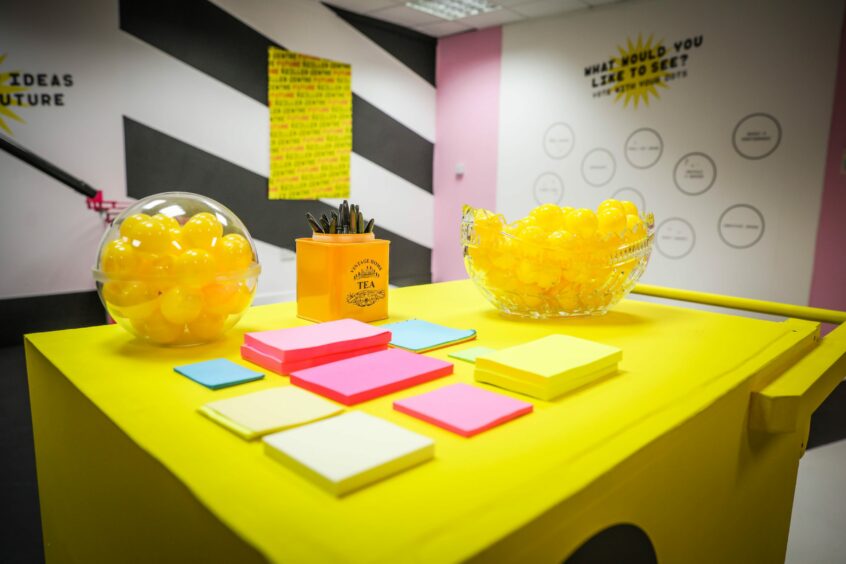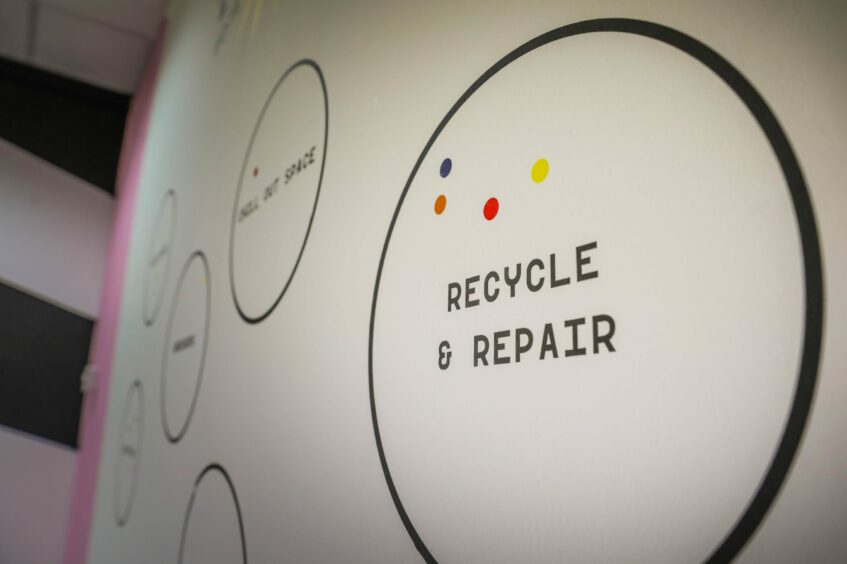Something needs done about the Keiller Centre.
It’s a refrain that echoes across city council meetings, two-star TripAdvisor reviews and Dundonians’ own dinner tables.
In a familiar story of high-street death, repeated along Reform Street and into the Wellgate, the Keiller Centre is mainly populated with shuttered units.
The once well-loved centre has gone from shopping hub to shortcut, with citizens more likely to use its roof as shelter from the rain when crossing the city centre than to stop at its ever-rarer retail offerings.
It is, many agree, a shame.
But rather than raze it and replace it with Dundee’s answer to Covent Garden, as was suggested in the city council’s ambitious 30-year plan last year, a tight-knit band of creative comrades wants to imagine a sweeter future for the former confectionery factory site.
Donna Holford-Lovell, director of digital arts organisation NEoN, knows something needs done; and she believes Dundonians themselves are the experts on what that ‘something’ is.
“The public already feel ownership of this building, because it’s theirs,” she explains. “It’s the real people of Dundee that come in here, and they’re already telling you what they feel.
“They have confidence to come and speak about what they want to see.”
That sense of ownership made Donna want to open up a bigger conversation, which is why she’s teamed up with Kathryn Rattray (director of Keiller Centre-based Federation art gallery) and Agency of None designer Lyall Bruce to create an interactive exhibition inside the centre.
Keiller Centre Future (which will end this evening) has invited passers-by to share their memories of the ‘old’ Keiller Centre, vote on ideas for the future, and suggest their own vision of what the city centre institution should be.
Dundee doesn’t need ‘Covent Garden’
Proposed uses for units in the centre so far include a video arcade, street food vendors, a night market, recycle and repair shops and coworking spaces.
And it’s clear that for Donna, these are not abstract concepts – there’s a vision here.
“Recycle and repair would be like this,” she begins, hands sketching out invisible characters in the air.
“Say your headphone lead breaks, so you would throw it away. Maybe there’s a space where you could come down, we’ve got the kit, you donate a couple of quid and we’ll teach you how to fix it.
“Meanwhile,” she goes on, “a ‘chill out space’ would be just what says – just an experience, to come and sit, and feel comfortable. A place where you don’t have to spend money if you don’t want to.
“We were also thinking this place would be ideal for an international street food market. That begs a night-time economy.
“So is there a possibility that we have half the space as a day service, and then you flip the switch and it almost becomes a different space?”
She leaves the question hanging in the air, and smiles.
“These are not new ideas, there are lots of precedents and examples around. But I think it’s about being flexible.”
But as much as precedents are helpful for inspiration, the Keiller Centre is a uniquely Dundonian building, with Dundonian problems.
And as far as the trio are concerned, ‘Dundee’s Covent Garden’ is not what the city’s people are looking for.
“Not only is [the Keiller Centre] a big piece of Dundee history, it’s also covered,” Kathryn points out matter-of-factly.
“Trying to have have anything open-air in Scotland is a pretty risky thing.”
“The problem with Dundee,” chimes in Lyall, who designed the exhibition, “is that we keep trying to take ideas from other places and bring them here, and it doesn’t work.
“We need to find what Dundee wants and create that.”
So what does Dundee want?
Retail rat race is not the way to win
“We don’t have the answers, that’s why we’re exploring,” Donna admits.
But in a post-pandemic Scotland, she’s doubtful that commodity-driven retail is the only answer.
“I think attitudes have changed because we’ve seen that actually, we can survive without going shopping, because we’ve all done it [during the pandemic],” she continues.
“I just think we need to stop the cycle of commodity, efficiency, capitalism. Communities need to take their space back.
“It’s been taken over by giant corporations. But it’s still a public space; it’s still our space.”
Amid swirling rumours of a possible Overgate takeover by Sports Direct tycoon Mike Ashley‘s corporation, Donna envisions a Keiller Centre which is an “alternative shopping experience”, dispensing with the overstimulation of large shopping centres, and which, rather than offering fast-fashion or luxury brands, is “more realistic about who lives here”.
But to bring that vision to life, she needs the people who live here to get involved – and dare to believe in better for their city centre.
Quick to baulk at buzzwords – “don’t say ‘grassroots’!” – Donna is doggedly realistic, and hyper-aware of the airy perception that arts collectives can have in a pragmatic, industrial landscapes like Dundee.
No-nonsense approach from NEoN founder
Originally from Stoke-on-Trent, the 50-year-old grew up destined to follow her mother into her hometown’s potteries industry.
But a stint working in Staffordshire’s New Vic theatre (“my job was to keep the lead actor’s prosthetic wound looking septic, and watch his dog”) led her into the arts, where she “faffed about” for several years before finding work in galleries in Scotland – which she sought out by working her way through the Yellow Pages until someone said ‘yes’.
Now she’s been the gallery manager at DJCAD, has started three businesses and is currently working on a PhD at Abertay University – but it’s important to her that places like the Keiller Centre continue to thrive, “because I shop in places like this”.
“I can’t stand big shopping centres, it’s not my thing. I grew up in Staffordshire, with an indoor market and scoopy shop and a charity shop,” she effuses.
“That,” she says, pointing at the unit across from us, “used to be the scoopy shop, and it was fabulous to come in and not waste packaging. And that was like, what, 20 years ago?”
Indeed, the exhibition was driven in part by the memories passers-by shared of “their” Keiller Centre, from decades gone by.
The ‘Toblerone of Time’, a pyramid of artefacts harking back to the days when the Swiss chocolate was produced by the Keiller confectionary factory, was designed by Lyall to get folk talking about their memories of the site’s glory days.
“We have to not forget what went on in here,” Donna insists.
“People have fond memories and we don’t want to ignore them. So we thought maybe some people’s memories could trigger ideas of things to bring back.”
And taking into account the centre’s manufacturing history, the team’s approach to a reinvented Keiller Centre is one driven by makers and menders, as well as spenders.
Challenge will ‘always be financial’
“It’s not about ‘inspiration’,” she goes on. “It’s about survival. It’s about people making a living.”
Key to that, Donna explains, is finding out not just what visitors want, but asking what small business owners, independent vendors and non-profit start-ups need too.
And though the team want to implement solar panels to save on energy costs and, eventually, free wifi and network services, they are the first people to point out that the biggest barrier to the centre’s reinvention will always be money.
“The challenge is always going to be financial,” Donna says.
“But if we can get a big enough community, maybe we can look at different ways of financing.
“Maybe there’s a means-tested way of charging rent, so maybe those who can make a profit pay a little more so that those that are non-profit don’t pay anything? Or maybe there’s scope for more short-term leases? Maybe people could sponsor a unit and bring in a charity.
“Or shop sharing – could two businesses share a shop and share those bills?
“Let’s say somebody can’t afford as much rent but they’re good at fixing things. Maybe you can pay with your skills, rather than money.
“It’s about a sharing economy, and it’s the old-fashioned look at a commons society, where you all pitch in.”
To the cynics, the exhibition team’s thinking may seem a little too ‘blue-sky’ for the current cost-of-living crisis cloud.
But as well as “a good working relationship” with Dundee City Council, Donna reveals that the owner of the Keiller Centre is supportive of their vision, and has even entertained the idea of eventually selling to a community trust group.
“The landlord doesn’t want to sell it to the highest bidder, necessarily, he’s keen for it to go to some local people and to support the tenants that are already here,” she says.
“Because let’s face it, he could’ve sold it years ago.”
Now the exhibition is ending, but the conversation is far from over.
Donna and her team are keen to facilitate talks between the dreamers and the doers of Dundee; in an era of generic email addresses and digital management, they are happy to be the faces for the Keiller Centre’s future, and welcome any and all to have a chat at the NEoN base, across from Federation Gallery.
Because at the heart of their mission, Donna insists, lies one question: ““How can we make the high street work for more people in a caring way?”

















Conversation